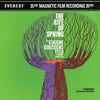



Stravinsky - Le Sacre du Printemps - Sir Eugene Goossens (2LP, 45 tours, 200g)
Igor Stravinsky - Le Sacre du Printemps
London Symphonie Orchestra
Sir Eugene Goossens - conductor
2 LP, Stoughton Printing tip-on old style original jacket artwork and Everest Records-branded jacket
Original analog Master tape : YES
Heavy Press : 200g
Record color : black
Speed : 45 RPM
Size : 12'’
Stereo
Studio
Record Press : Quality Record Pressings
Label : Classic Records (now part of Analogue Productions)
Original Label : Everest
Engineered, mixed and produced by Bert Whyte
Mastered by Bernie Grundman at Bernie Grundman Mastering
Originally released in 1960
Reissued in 2008
Tracks:
Side A:
- Le Sacre Du Printemps (The Rite of Spring) Part I
Side B:
- Blank Side
Side C:
- Le Sacre Du Printemps (The Rite of Spring) Part II
Side D:
- Le Sacre Du Printemps (The Rite of Spring) Part II Continued
Reviews:
“In May of 1913, just one year before the start of the first World War, Igor Stravinsky premiered his third ballet with the Ballets Russes in Paris: Le Sacre du printemps (The Rite of Spring). The premiere would go down in history for a number of reasons, primarily due to the unruly Parisian audience that descended into what could be referred to as a riot. What was so scandalous about the Rite? Stravinsky, along with choreographer Vaslav Nijinsky, wanted to evoke a picture of Russia from the distant, pagan past. A story of an ancient pagan rite where a young maiden would be chosen to dance herself to death to appease the ancestors and secure a bountiful harvest. The music, while stylistically not a huge departure from Stravinsky’s two previous and successful Parisian ballets, was dissonant, brutal, and rhythmically disorienting. Likewise, Nijinsky’s choreography was rigid, and was meant to mimic the flat, two-dimensional style of prehistoric paintings. The audience that night was not having it, but their uproar helped launch the Rite into infamy, helping it to become one of the most talked about and often performed works of the 20th century.
Fast-forward to 1959 when this recording was put to tape, or rather to 35mm film by famed engineer Bert Whyte. Everest, along with Mercury Living Presence were innovators in in the use of 35mm film for recording. The trend never caught on, but that doesn’t mean there were not serious advantages to the format, including increased dynamic range, a higher signal to noise ratio, and minimal wow and flutter. Here Eugene A. Goossens conducts the Rite with the London Symphony Orchestra. Goossens was very active in the mid-twentieth century as both a conductor and composer. He also was the brother of Leon Goossens, the most well regarded oboe soloist of the early 20th century. Goossens however, is most remembered today for a scandal in the mid-50s where he was implicated in an affair with Australian occultist Rosaleen Norton (dubbed “The Witch of King’s Cross”), a press scandal from which his career never fully recovered.
In the mid-2000s, Classic Records reissued some key 35mm titles from the Everest catalog, which proved how good the sound of the film stock was, and just how bad the original Everest pressings were at conveying it. These titles were cut by Bernie Grundman on his all-tube system at the time and released as 33rpm titles. However, Grundman also cut versions at 45rpm, which never received release until now. When Chad Kassem at Acoustic Sounds acquired Classic Records, he also acquired the metal parts for these 45rpm cuts, which have now been released by Analog Productions.
I own a few of these Everest reissues, both in their original 33 and 45 rpm iterations. The sound Bernie Grundman was able to coax out of these 35mm film reels is dynamic, vivid and breathtaking. This particular release is no exception. Bass drum hits and timpani thwacks rocked my listening room. Trumpet calls pierced through from the back of the convincingly-rendered hall, and the trombones menaced their way through the many climactic dance numbers that awaited them. Overall, the sound of this reissue is a sonic delight, determined to put your full-range speakers to the test. And not an overengineered one either I might add. This recording seems to lack the over mic’ing that plagued audiophile orchestral recordings in following decades (hello London Phase 4?). Unfortunately, the film appears to be stretched or warped in some way at the very start of the introduction, somewhat ruining the principal bassoons’ opening solo. There was also a bit of a recessed violin/viola sound, but it was difficult to determine if this was a recording issue or a performance issue, the latter of which are unfortunately common in this instance.
It’s strange to think about the fact that this recording was made in a time closer to the premier of this work than it is to our present day. I say this to point out that the Rite was considered astonishingly difficult when it first appeared, and although orchestras breeze through it nowadays, in the middle of the 20th century it likely was still considered a challenge. Back at the Manhattan School of Music, my Woodwind-Brass lab teacher, trumpeter Mark Gould once made a poor bassoonist play the opening solo a half step up in pitch, saying that the piece was “too easy” now, and everyone plays it too well. The goal was to make it hard again, as it would have been back in the day! But I digress…
The London Symphony Orchestra were certainly capable of greatness during this period in the 50s, the famed Dorati Firebird serves as a prime example. However, the performance here with Goossens at the helm suffers from strange artistic choices and some inconsistent playing. The “Augers of Spring” early on in the first part is almost anemic, and lacks any bite during the accented beats. In fact, if there is one overarching theme I can use to summarize this recording, it is primarily that it is too slow and dull in interpretation. That doesn’t mean there aren’t hints of greatness, however. The French Horns and Trombones all have stellar tutti features and sound at the top of their game, the concertmaster has some finely played solo sections, and the flutes provide a wide pallet of colors easily conveyed through the detailed soundstage.” Michael Leser Johnson, Analog Planet, May 16, 2021
Ratings :
Discogs : 4,21 / 5 , Analog Planet : Music 7/11, Sound 11/11


